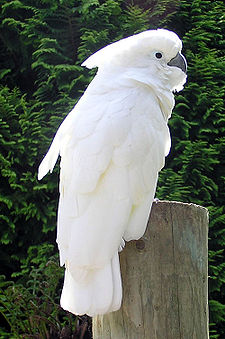
White Cockatoo
About this schools Wikipedia selection
This wikipedia selection has been chosen by volunteers helping SOS Children from Wikipedia for this Wikipedia Selection for schools. All children available for child sponsorship from SOS Children are looked after in a family home by the charity. Read more...
| Umbrella Cockatoo | |
|---|---|
 |
|
| Conservation status | |
|
Vulnerable
|
|
| Scientific classification | |
| Kingdom: | Animalia |
| Phylum: | Chordata |
| Class: | Aves |
| Order: | Psittaciformes |
| Family: | Cacatuidae |
| Subfamily: | Cacatuinae |
| Genus: | Cacatua |
| Subgenus: | Cacatua |
| Species: | C. alba |
| Binomial name | |
| Cacatua alba Müller, 1776 |
|
The Umbrella Cockatoo, Cacatua alba (also known as the White Cockatoo) is a medium-sized, up to 46 cm long cockatoo endemic to the islands of Halmahera, Bacan, Ternate, Tidore, Kasiruta and Mandiole in North Maluku, Indonesia. It is a white parrot with brown or black eyes and a dark grey beak. If it is surprised, it extends a large and striking crest, which has a semicircular shape (similar to an umbrella, hence the name). The crest is normally recumbent. The underside of the wings and tail have pale yellow or lemon colour, which flash when they fly.
The Umbrella Cockatoo can live up to, and perhaps beyond, 80 years in age. The Umbrella Cockatoo weighs about 400 grams for small females and up to 800 grams for big males. The male Umbrella cockatoo usually has a broader head and a bigger beak than the female.
During their puberty the female Umbrella cockatoo can begin to develop a more reddish iris than the male.
The feathers of the Umbrella Cockatoo are mostly white. However, both upper and lower surfaces of the inner half of the trailing edge of the large wing feathers are a yellow colour. The yellow colour is most notable on the underside of the wings because the yellow portion of the upper surface of the feather is covered by the white of the feather immediately medial (nearer to the body) and above. Similarly, areas of larger tail feathers that are covered by other tail feathers, and the innermost covered areas of the larger crest feathers, are yellow. Short white feathers grow from and closely cover the upper legs.
Conservation status
Although the Umbrella Cockatoo is not classified as an endangered species, it is classified as vulnerable. Its number in the wild have declined owing to habitat loss and illegal trapping for the cage-bird trade. It is listed in appendix II of the CITES list of protected species which gives it protection by making the export, import and trade of wild-caught birds illegal.
Aviculture
Umbrella Cockatoos are kept as pets because they bond closely with people and are valued for their beauty. They can imitate basic human speech, but are not considered the most able speakers among parrots. They are often used in live animal acts in zoos and amusement parks, because they are naturally acrobatic and easily trained, because of their highly social nature, and high level of intelligence.
Cockatoos require time, devotion and understanding from their caregivers. If left unsupervised they can damage furniture, moldings, walls, etc and inflict a potentially serious bite with their powerful beaks. Umbrella Cockatoo shed a white powdery feather dust, and this should be a consideration for those with allergies or asthma. Most Cockatoos, even those with the best care, are prone to develop unwanted behaviors such as screaming, feather plucking, self mutilation, and violence toward their caretakers or cagemates. Cockatoos are not domesticated pets and do not thrive as such. It is also important to consider their diet. A diet based solely on seeds and nuts simply is not sufficient. It's very important to get them eating primarily a pellet based diet and then to supplement it with fresh fruits and vegetables. The seeds and nuts because of their high fat content should be saved for treats and rewards.
The high market value of these birds has led to unsustainable levels of harvest for the pet trade. In 1994 the Umbrella Cockatoo was listed as a CITES I endangered species. This species has since been taken off the endangered species list, but is still listed as Vulnerable. Principal threats to this species are the pet trade and loss and degradation of their forest habitat.





